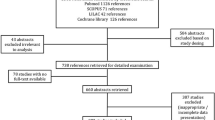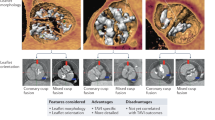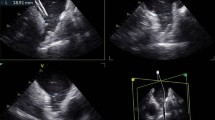Abstract
Paravalvular leak (PVL) is a complication that occurs in 5–17% of patients after surgical prosthetic valve implantation. Whereas PVLs can be benign, some PVLs are associated with substantial morbidity and mortality. Percutaneous closure using occluders specifically designed to improve closure and reduce procedural complications has now become the first-line treatment for PVL. In this Review, we first detail the frequency and clinical consequences of PVL closure. The role of cardiac imaging in the assessment and management of PVL, including echocardiographic imaging and adjunctive techniques such as CT, is then discussed, together with important considerations for the percutaneous closure of PVL, such as access site and device selection. Finally, we summarize the clinical evidence for percutaneous closure of PVL, including large national registries from Ireland, Spain and the UK, as well as head-to-head data comparing this procedure with surgical closure.
Key points
-
Paravalvular leak (PVL) is an important complication of valve replacement surgery and is associated with substantial morbidity and mortality.
-
Evidence is emerging for the important role of percutaneous transcatheter closure as the first-line treatment for patients with PVL.
-
The role of imaging, particularly fluoroscopy and 3D transoesophageal echocardiography, is important in the assessment, planning and treatment of PVLs.
-
A structural heart team approach (with all relevant specialists) is critical for good clinical decision making for patients with PVLs.
This is a preview of subscription content, access via your institution
Access options
Access Nature and 54 other Nature Portfolio journals
Get Nature+, our best-value online-access subscription
$29.99 / 30 days
cancel any time
Subscribe to this journal
Receive 12 print issues and online access
$209.00 per year
only $17.42 per issue
Buy this article
- Purchase on SpringerLink
- Instant access to full article PDF
Prices may be subject to local taxes which are calculated during checkout





Similar content being viewed by others
Change history
18 March 2019
In the version of this article initially published online, the Paravalvular Leak Device (PLD; Occlutech) was incorrectly described as having a “proximal disc that is slightly larger than the distal disc”, whereas the distal disc is actually slightly larger than the proximal disc. This error has been corrected for the HTML, PDF and print versions of the article.
References
Taramasso, M. et al. Surgical treatment of paravalvular leak: long-term results in a single-center experience (up to 14 years). J. Thorac Cardiovasc. Surg. 149, 1270–1275 (2015).
Genoni, M. et al. Paravalvular leakage after mitral valve replacement: improved long-term survival with aggressive surgery? Eur. J. Cardiothorac Surg. 17, 14–19 (2000).
Akins, C. W. et al. Early and late results of the surgical correction of cardiac prosthetic paravalvular leaks. J. Heart Valve Dis. 14, 792–799; discussion 799–800 (2005).
Garcia, E. et al. Outcomes and predictors of success and complications for paravalvular leak closure: an analysis of the SpanisH real-wOrld paravalvular LEaks closure (HOLE) registry. EuroIntervention 12, 1962–1968 (2017).
Calvert, P. A. et al. Percutaneous device closure of paravalvular leak: combined experience from the United Kingdom and Ireland. Circulation 134, 934–944 (2016).
Ruiz, C. E. et al. Clinical outcomes in patients undergoing percutaneous closure of periprosthetic paravalvular leaks. J. Am. Coll. Cardiol. 58, 2210–2217 (2011).
Sorajja, P., Cabalka, A. K., Hagler, D. J. & Rihal, C. S. Long-term follow-up of percutaneous repair of paravalvular prosthetic regurgitation. J. Am. Coll. Cardiol. 58, 2218–2224 (2011).
Sorajja, P., Cabalka, A. K., Hagler, D. J. & Rihal, C. S. Percutaneous repair of paravalvular prosthetic regurgitation: acute and 30-day outcomes in 115 patients. Circ. Cardiovasc. Interv. 4, 314–321 (2011).
Hein, R., Wunderlich, N., Robertson, G., Wilson, N. & Sievert, H. Catheter closure of paravalvular leak. EuroIntervention 2, 318–325 (2006).
Seery, T. J. & Slack, M. C. Percutaneous closure of a prosthetic pulmonary paravalvular leak. Congenit. Heart Dis. 9, E19–E22 (2014).
Turner, M. E., Lai, W. W. & Vincent, J. A. Percutaneous closure of tricuspid paravalvular leak. Catheter. Cardiovasc. Interv. 82, E511–E515 (2013).
Hammermeister, K. et al. Outcomes 15 years after valve replacement with a mechanical versus a bioprosthetic valve: final report of the Veterans Affairs randomized trial. J. Am. Coll. Cardiol. 36, 1152–1158 (2000).
Ionescu, A., Fraser, A. G. & Butchart, E. G. Prevalence and clinical significance of incidental paraprosthetic valvar regurgitation: a prospective study using transoesophageal echocardiography. Heart 89, 1316–1321 (2003).
Rallidis, L. S., Moyssakis, I. E., Ikonomidis, I. & Nihoyannopoulos, P. Natural history of early aortic paraprosthetic regurgitation: a five-year follow-up. Am. Heart J. 138, 351–357 (1999).
Davila-Roman, V. G. et al. Prevalence and severity of paravalvular regurgitation in the Artificial Valve Endocarditis Reduction Trial (AVERT) echocardiography study. J. Am. Coll. Cardiol. 44, 1467–1472 (2004).
De Cicco, G. et al. Mitral valve periprosthetic leakage: anatomical observations in 135 patients from a multicentre study. Eur. J. Cardiothorac Surg. 30, 887–891 (2006).
Leon, M. B. et al. Transcatheter aortic-valve implantation for aortic stenosis in patients who cannot undergo surgery. N. Engl. J. Med. 363, 1597–1607 (2010).
Smith, C. R. et al. Transcatheter versus surgical aortic-valve replacement in high-risk patients. N. Engl. J. Med. 364, 2187–2198 (2011).
Athappan, G. et al. Incidence, predictors, and outcomes of aortic regurgitation after transcatheter aortic valve replacement: meta-analysis and systematic review of literature. J. Am. Coll. Cardiol. 61, 1585–1595 (2013).
Van Belle, E. et al. Postprocedural aortic regurgitation in balloon-expandable and self-expandable transcatheter aortic valve replacement procedures: analysis of predictors and impact on long-term mortality: insights from the FRANCE2 Registry. Circulation 129, 1415–1427 (2014).
Wendt, D. et al. Low incidence of paravalvular leakage with the balloon-expandable sapien 3 transcatheter heart valve. Ann. Thorac Surg. 100, 819–825; discussion 825–826 (2015).
Webb, J. et al. Multicenter evaluation of a next-generation balloon-expandable transcatheter aortic valve. J. Am. Coll. Cardiol. 64, 2235–2243 (2014).
Thompson, D. S. et al. Analysis of left ventricular pressure during isovolumic relaxation in coronary artery disease. Circulation 65, 690–697 (1982).
Sawant, D., Singh, A. K., Feng, W. C., Bert, A. A. & Rotenberg, F. St. Jude Medical cardiac valves in small aortic roots: follow-up to sixteen years. J. Thorac Cardiovasc. Surg. 113, 499–509 (1997).
Nietlispach, F. et al. Percutaneous paravalvular leak closure: chasing the chameleon. Eur. Heart J. 37, 3495–3502 (2016).
Yakubov, S. J. et al. 2-year outcomes after iliofemoral self-expanding transcatheter aortic valve replacement in patients with severe aortic stenosis deemed extreme risk for surgery. J. Am. Coll. Cardiol. 66, 1327–1334 (2015).
Lancellotti, P. et al. Recommendations for the imaging assessment of prosthetic heart valves: a report from the European Association of Cardiovascular Imaging endorsed by the Chinese Society of Echocardiography, the Inter-American Society of Echocardiography, and the Brazilian Department of Cardiovascular Imaging. Eur. Heart J. Cardiovasc. Imag. 17, 589–590 (2016).
Jayawardena, S., Sooriabalan, D., Burzyantseva, O. & Sinnapunayagm, S. Paravalvular mitral valve leakage presenting as congestive heart failure, missed by TTE but diagnosed by TEE: a case report. Cases J. 1, 216 (2008).
Deftereos, S., Giannopoulos, G., Raisakis, K., Kaoukis, A. & Kossyvakis, C. Intracardiac echocardiography imaging of periprosthetic valvular regurgitation. Eur. J. Echocardiogr. 11, E20 (2010).
Jelnin, V. et al. Three dimensional CT angiography for patients with congenital heart disease: scanning protocol for pediatric patients. Catheter. Cardiovasc. Interv. 67, 120–126 (2006).
Lesser, J. R. et al. Use of cardiac CT angiography to assist in the diagnosis and treatment of aortic prosthetic paravalvular leak: a practical guide. J. Cardiovasc. Comput. Tomogr. 9, 159–164 (2015).
Suh, Y. J. et al. Assessment of mitral paravalvular leakage after mitral valve replacement using cardiac computed tomography: comparison with surgical findings. Circ. Cardiovasc. Imaging 9, e004153 (2016).
Clegg, S. D. et al. Integrated 3D echo-x ray to optimize image guidance for structural heart intervention. JACC Cardiovasc. Imag. 8, 371–374 (2015).
de Agustin, J. A., Jimenez-Quevedo, P., Nombela-Franco, L., Gomez de Diego, J. J. & Perez de Isla, L. Paravalvular mitral leak closure under Eco-X-ray fusion guidance. Eur. Heart J. Cardiovasc. Imaging 19, 586 (2018).
Faletra, F. F. et al. Echocardiographic-fluoroscopic fusion imaging for transcatheter mitral valve repair guidance. Eur. Heart J. Cardiovasc. Imaging 19, 715–726 (2018).
Hascoet, S. et al. Multimodality imaging guidance for percutaneous paravalvular leak closure: insights from the multi-centre FFPP register. Arch. Cardiovasc. Dis. 111, 421–431 (2018).
Pflaumer, A., Schwaiger, M., Hess, J., Lange, R. & Stern, H. Quantification of periprosthetic valve leakage with multiple regurgitation jets by magnetic resonance imaging. Pediatr. Cardiol. 26, 593–594 (2005).
Zoghbi, W. A. et al. Recommendations for evaluation of prosthetic valves with echocardiography and doppler ultrasound: a report from the American Society of Echocardiography’s Guidelines and Standards Committee and the Task Force on Prosthetic Valves, developed in conjunction with the American College of Cardiology Cardiovascular Imaging Committee, Cardiac Imaging Committee of the American Heart Association, the European Association of Echocardiography, a registered branch of the European Society of Cardiology, the Japanese Society of Echocardiography and the Canadian Society of Echocardiography, endorsed by the American College of Cardiology Foundation, American Heart Association, European Association of Echocardiography, a registered branch of the European Society of Cardiology, the Japanese Society of Echocardiography, and Canadian Society of Echocardiography. J. Am. Soc. Echocardiogr. 22, 975–1014 (2009).
Becerra, J. M., Almeria, C., de Isla, L. P. & Zamorano, J. Usefulness of 3D transoesophageal echocardiography for guiding wires and closure devices in mitral perivalvular leaks. Eur. J. Echocardiogr. 10, 979–981 (2009).
Enriquez-Sarano, M. et al. Determinants of pulmonary venous flow reversal in mitral regurgitation and its usefulness in determining the severity of regurgitation. Am. J. Cardiol. 83, 535–541 (1999).
Mahjoub, H. et al. Description and assessment of a common reference method for fluoroscopic and transesophageal echocardiographic localization and guidance of mitral periprosthetic transcatheter leak reduction. JACC Cardiovasc. Interv. 4, 107–114 (2011).
Lázaro, C., Hinojar, R. & Zamorano, J. L. Cardiac imaging in prosthetic paravalvular leaks. Cardiovasc. Diagn. Ther. 4, 307–313 (2014).
Garcia-Fernandez, M. A. et al. Utility of real-time three-dimensional transesophageal echocardiography in evaluating the success of percutaneous transcatheter closure of mitral paravalvular leaks. J. Am. Soc. Echocardiogr. 23, 26–32 (2010).
Franco, E. et al. Three-dimensional color Doppler transesophageal echocardiography for mitral paravalvular leak quantification and evaluation of percutaneous closure success. J. Am. Soc. Echocardiogr. 27, 1153–1163 (2014).
Lancellotti, P. et al. Recommendations for the echocardiographic assessment of native valvular regurgitation: an executive summary from the European Association of Cardiovascular Imaging. Eur. Heart J. Cardiovasc. Imaging 14, 611–644 (2013).
Tribouilloy, C. et al. End diastolic flow velocity just beneath the aortic isthmus assessed by pulsed Doppler echocardiography: a new predictor of the aortic regurgitant fraction. Br. Heart J. 65, 37–40 (1991).
Hildick-Smith, D., Behan, M. W. & De Giovanni, J. Percutaneous closure of an aortic paravalvular leak via the transradial approach. Catheter. Cardiovasc. Interv. 69, 708–710 (2007).
Jolly, S. S. et al. Radial versus femoral access for coronary angiography and intervention in patients with acute coronary syndromes (RIVAL): a randomised, parallel group, multicentre trial. Lancet 377, 1409–1420 (2011).
Ruparelia, N. et al. Paravalvular leak closure under intracardiac echocardiographic guidance. Catheter. Cardiovasc. Interv. 91, 958–965 (2018).
Al’Aref, S. J., Devereux, R. B., Cheung, J. W. & Bergman, G. Bioprosthetic mitral valve paravalvular leak closure using intracardiac echocardiography-guided three dimensional electroanatomic mapping. Catheter. Cardiovasc. Interv. 92, E135–E138 (2018).
Rihal, C. S., Sorajja, P., Booker, J. D., Hagler, D. J. & Cabalka, A. K. Principles of percutaneous paravalvular leak closure. JACC Cardiovasc. Interv. 5, 121–130 (2012).
Singh, P. et al. Live/real time three-dimensional transesophageal echocardiographic evaluation of mitral and aortic valve prosthetic paravalvular regurgitation. Echocardiography 26, 980–987 (2009).
Arribas-Jimenez, A. et al. Utility of real-time 3-dimensional transesophageal echocardiography in the assessment of mitral paravalvular leak. Circ. J. 80, 738–744 (2016).
Biner, S., Rafique, A. M., Kar, S. & Siegel, R. J. Live three-dimensional transesophageal echocardiography-guided transcatheter closure of a mitral paraprosthetic leak by Amplatzer occluder. J. Am. Soc. Echocardiogr. 21, 1282–1289 (2008).
Smolka, G. et al. Multiplug paravalvular leak closure using amplatzer vascular plugs III: a prospective registry. Catheter. Cardiovasc. Interv. 87, 478–487 (2016).
Goktekin, O. et al. Transcatheter trans-apical closure of paravalvular mitral and aortic leaks using a new device: first in man experience. Catheter. Cardiovasc. Interv. 83, 308–314 (2014).
Bedair, R. et al. Early experience with the Occlutech PLD occluder for mitral paravalvar leak closure through a hybrid transapical approach. EuroIntervention 12, e1420–e1427 (2016).
Pestrichella, V. et al. Transcatheter simultaneous double-transapical access for paravalvular mitral leak closure using the Occlutech PLD. J. Invasive Cardiol. 28, E66–E68 (2016).
Roy, J. et al. Simultaneous transseptal para-ring leak closure and transcatheter mitral valve implantation for the treatment of surgical mitral repair failure. Heart Lung Circ. 26, e71–e75 (2017).
McElhinney, D. B. Will there ever be a Food and Drug Administration-approved device for transcatheter paravalvular leak closure? Circ. Cardiovasc. Interv. 7, 2–5 (2014).
Gafoor, S. et al. Tools and techniques — clinical: paravalvular leak closure. EuroIntervention 9, 1359–1363 (2014).
Hahn, R. T. et al. Outcomes with post-dilation following transcatheter aortic valve replacement: the PARTNER I trial (placement of aortic transcatheter valve). JACC Cardiovasc. Interv. 7, 781–778 (2014).
Nietlispach, F. & Maisano, F. Balloon post-dilation after transcatheter aortic valve replacement: a solution worth trying in patients with residual aortic insufficiency. JACC Cardiovasc. Interv. 7, 790–791 (2014).
Murdoch, D. J., Sathananthan, J., Cheung, A. & Webb, J. G. Combined transapical valve-in-valve/valve-in-ring transcatheter mitral valve implantation and paravalvular leak closure for failed mitral valve surgery. Can J. Cardiol. 34, 1088.e3–1088.e6 (2018).
Eskandari, M. et al. Transcatheter valve-in-valve therapy using a balloon expanding valve for treatment of aortic paravalvular leakage. Heart Lung Circ. https://doi.org/10.1016/j.hlc.2018.06.1045 (2018).
Cruz-Gonzalez, I. et al. Transcatheter closure of paravalvular leaks: state of the art. Neth. Heart J. 25, 116–124 (2017).
Emery, R. W., Krogh, C. C., McAdams, S., Emery, A. M. & Holter, A. R. Long-term follow up of patients undergoing reoperative surgery with aortic or mitral valve replacement using a St. Jude Medical prosthesis. J. Heart Valve Dis. 19, 473–484 (2010).
Echevarria, J. R. et al. Reoperation for bioprosthetic valve dysfunction. A decade of clinical experience. Eur. J. Cardiothorac Surg. 5, 523–526; discussion 527 (1991).
Hourihan, M. et al. Transcatheter umbrella closure of valvular and paravalvular leaks. J. Am. Coll. Cardiol. 20, 1371–1377 (1992).
Piechaud, J. F. Percutaneous closure of mitral paravalvular leak. J. Interv Cardiol. 16, 153–155 (2003).
Webb, J. G., Pate, G. E. & Munt, B. I. Percutaneous closure of an aortic prosthetic paravalvular leak with an Amplatzer duct occluder. Catheter. Cardiovasc. Interv. 65, 69–72 (2005).
Sorajja, P., Cabalka, A. K., Hagler, D. J. & Rihal, C. S. The learning curve in percutaneous repair of paravalvular prosthetic regurgitation: an analysis of 200 cases. JACC Cardiovasc. Interv. 7, 521–529 (2014).
Waterbury, T. M. et al. Techniques and outcomes of paravalvular leak repair after transcatheter aortic valve replacement. Catheter. Cardiovasc. Interv. 90, 870–877 (2017).
Feldman, T., Salinger, M. H., Levisay, J. P. & Smart, S. Low profile vascular plugs for paravalvular leaks after TAVR. Catheter. Cardiovasc. Interv. 83, 280–288 (2014).
Angulo-Llanos, R. et al. Two-year follow up after surgical versus percutaneous paravalvular leak closure: a non-randomized analysis. Catheter. Cardiovasc. Interv. 88, 626–634 (2016).
Pinheiro, C. P. et al. Paravalvular regurgitation: clinical outcomes in surgical and percutaneous treatments. Arq. Bras. Cardiol. 107, 55–62 (2016).
Wells, J. A. t. et al. Outcomes after paravalvular leak closure: transcatheter versus surgical approaches. JACC Cardiovasc. Interv. 10, 500–507 (2017).
Taramasso, M. et al. Conventional surgery and transcatheter closure via surgical transapical approach for paravalvular leak repair in high-risk patients: results from a single-centre experience. Eur. Heart J. Cardiovasc. Imaging 15, 1161–1167 (2014).
Millan, X. et al. Surgery versus transcatheter interventions for significant paravalvular prosthetic leaks. JACC Cardiovasc. Interv. 10, 1959–1969 (2017).
Pilgrim, T. & Franzone, A. Strategies for paravalvular prosthetic leak closure: competing or complementary? JACC Cardiovasc. Interv. 10, 1970–1972 (2017).
Alkhouli, M. et al. Transcatheter and surgical management of mitral paravalvular leak: long-term outcomes. JACC Cardiovasc. Interv. 10, 1946–1956 (2017).
Ruiz, C. E. et al. Clinical trial principles and endpoint definitions for paravalvular leaks in surgical prosthesis: an expert statement. J. Am. Coll. Cardiol. 69, 2067–2087 (2017).
Author information
Authors and Affiliations
Contributions
J.P.G. researched data for the article and wrote the manuscript. B.S.R. produced the clinical images. All the authors provided substantial contribution to the discussion of content and reviewed and edited the manuscript before submission.
Corresponding author
Ethics declarations
Competing interests
The authors declare no competing interests.
Additional information
Publisher’s note
Springer Nature remains neutral with regard to jurisdictional claims in published maps and institutional affiliations.
Rights and permissions
About this article
Cite this article
Giblett, J.P., Rana, B.S., Shapiro, L.M. et al. Percutaneous management of paravalvular leaks. Nat Rev Cardiol 16, 275–285 (2019). https://doi.org/10.1038/s41569-018-0147-0
Published:
Issue Date:
DOI: https://doi.org/10.1038/s41569-018-0147-0
This article is cited by
-
Numerical evaluation of transcatheter aortic valve performance during heart beating and its post-deployment fluid–structure interaction analysis
Biomechanics and Modeling in Mechanobiology (2020)



